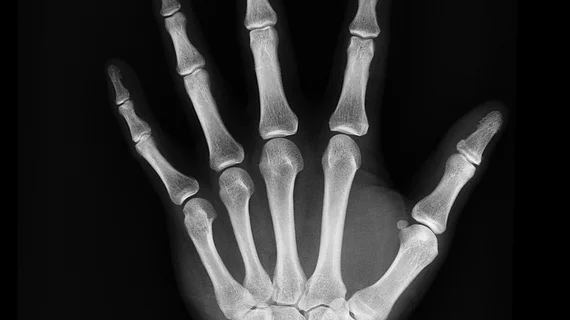Hand trauma patients who require radiology services face significantly higher odds of receiving a surprise medical bill, according to new research.
The emergency department is one of the most common sources of such unexpected IOUs, with upward of 43% of visits resulting in a surprise bill. And upper hand extremities are a frequent reason for ED encounters that sometimes require transfers to higher-level care centers, despite a patient’s intent to use an in-network facility.
Experts with the Baltimore-based Curtis National Hand Center—one of the largest of its kind in the world—sought to unearth factors that might increase one’s odds of receiving a surprise bill. Among physicians, radiologists and pathologists had the highest association, both presenting a 132% higher risk of producing unanticipated debt for their encounter, experts wrote in the Journal of Hand Surgery.
“Although the incidence of surprise billing decreased over time, the wide geographic variation across states suggests that the problem persists,” Chao Long MD, a research fellow at the hand center and plastic and reconstructive surgery resident at Johns Hopkins, wrote Nov. 8. “The source of surprise bills is widely varied, including both physician and nonphysician providers, and placing hand trauma patients requiring multidisciplinary care at high risk. Hand surgery as a specialty can advocate for comprehensive policies to better protect our patients from financial exploitation.”
For the study, Long et al. used IBM MarketScan commercial claims covering care spanning from 2010 to 2017. They landed on a final sample of nearly 711,000 encounters, with almost 98,000 (or 14%) involving a surprise medical bill. Such instances decreased from 26% at the study’s start down to 11% by its conclusion. Average coinsurance payments were higher for surprise billing encounters, with double the growth over the seven years compared to those without an unexpected tab. Facility transfers occurred in only about 0.5% of patients who received a surprise bill, while radiologist services occurred most frequently at 21%.
The authors also discovered that other nonphysician providers, such as therapists (147%), also increased the odds of receiving a surprise bill. And the practice is widespread, existing “to varying degrees” in every U.S. state, despite 21 having legislation to address this concern at the time of the study, which likely contributed to decreases in the study. As of February, 33 states have enacted surprise billing laws and the federal government is now working on a national version.
“Altogether, these findings are particularly concerning because patients with hand or upper extremity trauma frequently require a multidisciplinary team. As such, the odds and resultant magnitude of surprise billing accumulate,” the authors advised.

